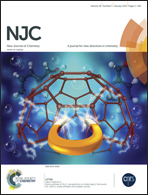Hydrogen-bonded chiral molecular switches: photo- and thermally-reversible switchable full range color in the self-organized helical superstructure
Abstract
In this study, new kinds of hydrogen-bonded (H-bonded) chiral molecular switches (CMS) composed of azobenzene moieties as photo-responsive parts and H-bonded complexes as thermo-responsive parts were developed. Photo- and thermally-reversible switching behavior of cholesteric liquid crystals (Ch-LCs) based on the H-bonded CMS was investigated in detail. The results demonstrate that H-bonded CMS undergo a trans–cis photoisomerization under UV light, which results in the decrease of helical twisting power (HTP). Meanwhile, the modulation of the intermolecular forces between proton donors and acceptors with temperature has a positive influence on the change in HTP. Reversible blue, green, and red reflections of the self-organized helical superstructure could be achieved under UV/Vis light as well as with temperature change. According to the geometry optimization based on Gaussian 03 calculations at the B3LYP/6-31G(d) level, the molecular aspect ratio could be considered to be one of the important factors influencing the HTP of H-bonded CMS. This dynamic tuning of the self-organized helical superstructure based on dual and selective molecular mechanism opens up a way to achieve new kinds of LC photonic materials.


 Please wait while we load your content...
Please wait while we load your content...